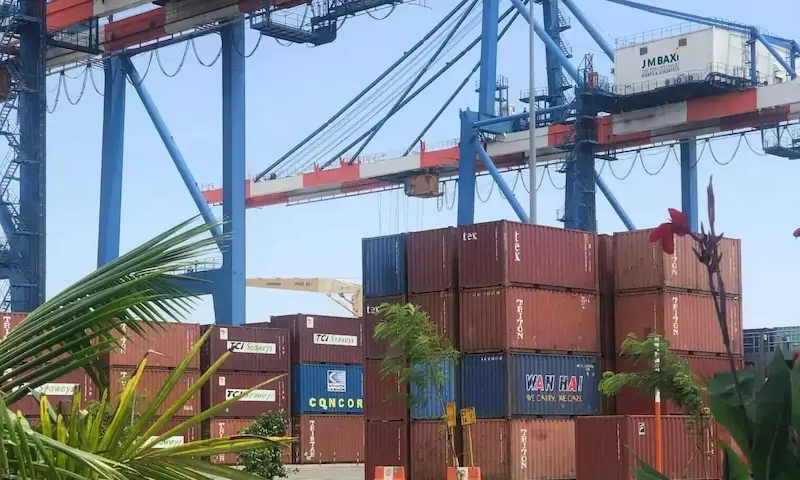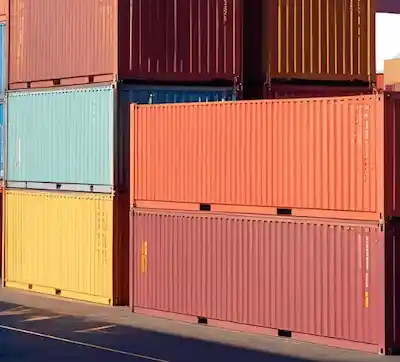Shipping container cost in India: Buy 30+ container types at the best price ’25

The rising volume of trade at India’s main ports has led to a precipitous decline in container prices throughout the year. The market now has an excess of containers, which has caused prices to drop. As a result, now is an excellent opportunity to purchase or lease a shipping container in the country.

Key Factors Affecting Shipping Container Costs in India
India’s domestic container shipping rates have changed under the impact of various important variables. The quantity of traffic at India’s ports is one important factor. When ports handle more cargo, container availability tends to increase, which leads to lower prices. This is because, in most cases, less expensive container utilization results from greater traffic.
An equally important factor is the connection between supply and demand. A price drop occurs when supply exceeds demand for containers. However, costs could go higher when demand outstrips supply. Global trade activity and local market needs impact this equilibrium.
The general state of the economy also affects India’s freight rates. A rise in the economy usually means more commerce — and more need for containers. However, when times are tough, trading may stagnate, which results in an oversupply of containers and eventually reduced prices. Import and export costs are also susceptible to changes in exchange rates.
Moreover, sea freight rates from India are affected to a large extent by policies enacted by governments. Improvements to port infrastructure, such as the Sagarmala Project, seek to increase efficiency and, by extension, decrease costs. Market dynamics and price structures are also influenced by trade agreements and regulations.

Overview of 30+ Shipping Container Types Available in India
Many different kinds of shipping containers are available in India, including:
- Standard dry containers. The most common type of container is often used for ordinary Indian container shipping. For the safe transportation of dry products like clothing and electronics, you may choose from three different sizes: 20 feet, 40 feet, and 40 feet-high cubes.
- Refrigerated containers (reefers). These containers with climate control are ideal for carrying perishable items, including medicines, fresh produce, and other perishable commodities.
- Open-top containers. These containers allow for cargo that is too tall to fit into a standard container. Great for transporting large objects and heavy equipment, they have an open top that may be covered with a tarp.
- Flat rack containers. Unlike regular containers, flat rack containers have foldable sides and are ideal for transporting large and bulky items like automobiles and industrial machinery.
- Tank containers. These containers are used in the food and chemical sectors to carry bulk liquids safely and efficiently; they are specially built for gasses, powders, and liquids.
- Ventilated containers. These containers are designed with ventilation apertures to provide proper air circulation and avoid the accumulation of moisture. They are typically used for organic goods like coffee and cocoa beans.
- Insulated containers. Ideal for commodities that need protection from heat or cold, insulated containers maintain a constant temperature, similar to reefers but without active cooling systems.
- Half-height containers. These containers are half the height of regular containers; they are ideal for transporting thick, heavy goods like gravel and minerals since they are easier to load and unload.
- Car carriers. Car carriers have ramps for simple loading and unloading and secure connections to carry automobiles.
- Pallet-wide containers. These containers are slightly wider than standard ones, allowing for more pallets (especially the European-sized ones) to be loaded side-by-side.
- Tunnel containers. For activities that need a rapid turnaround, tunnel containers are an excellent choice because of the ease of loading and unloading them.
- Open-side containers. Their side doors are ideal for large, awkward objects that would be difficult to load via regular doors.
- Double-door containers. They are often used in the construction sector for convenient access to supplies; their dual-door design allows for diverse loading possibilities.
- High cube containers. With an additional foot of height compared to regular containers, high cube containers provide enough capacity for large objects.
- Hard-top containers. The steel roofs of these containers are detachable, so you may load big, heavy equipment or other items from the top instead of the side.
- Bulk containers. These containers often have hatches that facilitate loading and unloading; they’re ideal for carrying bulk products such as fertilizers and grains.
- Special purpose containers. These containers are versatile and may be adapted to carry anything from modular house modules to cattle.
- Flexi-tanks. These are large, flexible bags fitted inside standard containers, used for transporting non-hazardous liquids in bulk.
- Platform containers. These containers are essentially flatbeds, used for big cargoes, such as heavy construction equipment, that need an open platform.
- Mini containers. When a full-sized container isn’t required for carrying a lower quantity of material, these smaller containers are used.
- Quadcon and Tricon containers. These are modular containers that can be combined to form a standard-sized container, used for military logistics and remote operations.
- Office containers. Converted containers with office fittings are used on construction sites and in remote locations as temporary offices.
- Accommodation units. These shipping containers are transformed into dwellings, which are used as short-term housing in outlying regions or during times of crisis.
- Hazardous goods containers. These containers include extra security elements to ensure they fulfill rules for carrying hazardous goods securely.
- Art containers. These specially designed containers include temperature control and enough padding to safeguard priceless and fragile artworks during transportation.
- Animal transport containers. These containers have ventilation and space for movement to guarantee the safe and humane transport of live animals.
- Explosive-proof containers. These are reinforced containers used for transporting explosive materials, built to contain any accidental detonations.
- Waste skip containers. These sturdy containers are perfect for garbage collection and transportation since they are simple to load and unload.
- Drilling rig containers. These containers are designed specifically for the oil and gas sector and include the necessary features to carry drilling equipment securely.
- Cargo storage roll containers. Easily maneuvered on wheels, they are used for transferring merchandise in retail and warehouse settings.
When you know what to look for in a shipping container, you can select the one that best suits your India container shipping needs. However, you should also take into account sea freight rates from India.

Cost Comparison Between New and Used Containers
Comparing new versus used domestic container shipping rates could be difficult, but we’ve done the math to help you make an informed decision. A new 20-foot container at Nhava Sheva (Mumbai) can set you back about $2,118 if you want the highest quality.
Used containers, on the other hand, are a great option for those hoping to save costs. Just $896 gets you a cargo-worthy 20-footer in the same area. The price of a 40ft Costo container ranges from $1,288 in Nhava Sheva to $1,507 in Mundra. Compared to brand-new containers, the cost difference is substantial, yet these used ones will also carry your items securely.
A shipping cost of a 20-foot container will save you $1,222 USD in this case. Think about all the things you could buy with the money you save. The decision is in your hands.

Refrigerated Container Costs and Availability in India
Reefers are necessary for the transportation of perishable goods, including medications, meat, and frozen meals. In India, reefer costs usually vary. You may expect to pay about $1,500 to $2,500 for a 20-foot container and $3,000 to $5,000 for a 40-foot one. Indian freight rates are usually affected by factors such as seasonal demands, container conditions, currency rates, and worldwide demand.
The most popular places to get these containers are major ports like Mundra, Chennai, and Nhava Sheva (Mumbai). Because of their centrality to both the importing and exporting processes, these locations are perfect for purchasing a reefer and transporting this container from India to the USA, for example.
Cost-Saving Tips for Shipping Container Purchases
To get the best rates and save money on a container cost from India to the USA, follow these tips:
- Choose between a new and a used Costco container based on your needs. In most cases, you can get just as much use out of used containers for a lot less money.
- Make a bulk purchase if you need a lot of containers. Suppliers often offer discounts for larger orders, reducing the overall cost per unit.
- Don’t hesitate to haggle. Many sellers are open to negotiation, especially if you’re buying more than one container or paying upfront.
- Be aware of additional costs such as delivery charges, taxes, handling fees, or how much is shipping to India. Clarify these details upfront to avoid unexpected expenses.
- Monitor the market. Volatility in transportation industry cycles, currency exchange rates, and worldwide demand may all affect prices. A great way to save money is to buy a shipping container when the market is down.
- Take your time and don’t accept the first quotation you get. If you want to receive the greatest bargain, you should compare rates from several vendors.
- If you can, check containers in person to be sure they are in excellent shape and can handle your demands, particularly if you are buying used containers.
- Location may sometimes affect the pricing. Seek more affordable rates by comparing pricing at several ports or locations, if possible.
- Use online marketplaces that specialize in shipping containers to access a wider range of options and competitive pricing.
Consider your future needs as well. Instead of spending money on upgrades or replacements down the road, consider investing in a large, sturdy container today.
Vanessa is a dedicated writer and content enthusiast at Pelican Containers. With a background in practical writing and a keen eye for clarity, she transforms complex container topics into easy-to-understand and useful content. Her passion lies in exploring the evolving world of container usage — from smart storage hacks to global logistics trends.
When she's not writing, Vanessa loves discovering creative shipping container projects or traveling to find new inspiration.
Explore thoughtful, informative, and accessible content with Vanessa!
Vanessa is a dedicated writer and content enthusiast at Pelican Containers. With a background in practical writing and a keen eye for clarity, she transforms complex container topics into easy-to-understand and useful content. Her passion lies in exploring the evolving world of container usage — from smart storage hacks to global logistics trends.
When she's not writing, Vanessa loves discovering creative shipping container projects or traveling to find new inspiration.
Explore thoughtful, informative, and accessible content with Vanessa!
FAQ
What are the main factors influencing shipping container costs in India?
Indian shipping container prices are sensitive to factors such as supply and demand on a worldwide scale, the container’s age and condition, the value of the Rupee relative to other currencies, and the fluctuation of seasonal demand.
What are the different types of shipping containers available in India?
Depending on your demands, you may choose from a wide range of shipping containers in India. They include regular dry containers, refrigerated containers (reefers) for temperature-sensitive items, specialized containers for enormous or oddly shaped cargo, and more.
How do costs vary between new and used shipping containers?
Due to their superior quality and extended lifetime, new shipping containers are often priced more. Used containers, on the other hand, are often less expensive and are still highly effective for most purposes.
What are the price trends for shipping containers in India in 2025?
Shipping container costs in India fluctuate in 2025 due to factors including changes in the worldwide market, demand from important sectors like food and pharmaceuticals, and exchange rate movements.











